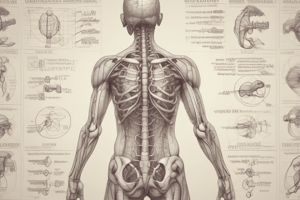Podcast
Questions and Answers
A CXR usually does not show which of the following?
A CXR usually does not show which of the following?
- Cardiac silhouette
- Diaphragm
- Hilar
- Liver (correct)
Ventricular repolarization represents which of the following?
Ventricular repolarization represents which of the following?
- Systole
- Contraction
- Ventricular Relaxation (correct)
- Ejection
Which chamber of the heart has the thickest wall because it pumps blood to the systemic circuit?
Which chamber of the heart has the thickest wall because it pumps blood to the systemic circuit?
- Left ventricle (correct)
- Right atrium
- Left atrium
- Right ventricle
The P wave on an EKG tracing represents which of the following?
The P wave on an EKG tracing represents which of the following?
What does the QRS complex represent in an EKG?
What does the QRS complex represent in an EKG?
A hiatal hernia can be detected on a CXR if the stomach is seen below the diaphragm. Is this statement true or false?
A hiatal hernia can be detected on a CXR if the stomach is seen below the diaphragm. Is this statement true or false?
The right diaphragm is higher than the left due to the presence of which organ?
The right diaphragm is higher than the left due to the presence of which organ?
Which of the following views is best for observing the right middle lobe on a CXR?
Which of the following views is best for observing the right middle lobe on a CXR?
Flashcards
Why is the liver not visible on a CXR?
Why is the liver not visible on a CXR?
A CXR is an X-ray of the chest. The liver is not typically visible on a CXR because it is located behind the ribs. The hilar region, diaphragm, and cardiac silhouette are all visible on a CXR.
What does ventricular repolarization represent?
What does ventricular repolarization represent?
Ventricular repolarization is the process of the ventricles returning to their resting state after contraction. This is associated with relaxation.
Why does the left ventricle have the thickest wall?
Why does the left ventricle have the thickest wall?
The left ventricle is responsible for pumping oxygenated blood to the entire body. It needs a thicker wall to generate the force necessary for systemic circulation.
What does the P wave on an EKG represent?
What does the P wave on an EKG represent?
Signup and view all the flashcards
What does the QRS complex on an EKG represent?
What does the QRS complex on an EKG represent?
Signup and view all the flashcards
Can a hiatal hernia be detected on a CXR if the stomach is seen below the diaphragm?
Can a hiatal hernia be detected on a CXR if the stomach is seen below the diaphragm?
Signup and view all the flashcards
Why is the right diaphragm higher than the left?
Why is the right diaphragm higher than the left?
Signup and view all the flashcards
Which CXR view is best for visualizing the right middle lobe?
Which CXR view is best for visualizing the right middle lobe?
Signup and view all the flashcards
Study Notes
Multiple Choice Questions
- Question 1: A chest X-ray (CXR) typically does not show the cardiac silhouette.
- Question 2: Ventricular repolarization represents ventricular relaxation.
- Question 3: The left ventricle has the thickest wall because it pumps blood to the systemic circuit.
- Question 4: The P wave on an EKG represents atrial depolarization.
- Question 5: The QRS complex represents ventricular depolarization.
- Question 6: A hiatal hernia can be detected on a CXR if the stomach is seen below the diaphragm — True.
- Question 7: The right diaphragm is higher than the left diaphragm due to the liver — True.
Matching Questions
- Question 8: The best view for a CXR to see the right middle lobe is the Right Anterior Oblique (RAO) view.
- Question 9: An assumption that people who are of a similar background, race, physical disability or culture are the same is called a stereotyping.
- Question 10: Labeling somebody in a way that hurts their standing in the community is called labeling.
- Question 11: Judging somebody without really knowing much about them is called prejudice.
- Question 12: Statement about common trends within a group, but with the recognition that further information is needed to ascertain whether the generalization applies to this particular person is a generalization.
Matching: Medical vs Patient Model
- Question 13-18: Statements related to the medical and patient models of care are described in the questions, but the notes about which statement belongs to which model are not present.
Etiquette Based Communication Skills
- Question 19: Three etiquette-based communication skills for patient recovery include: introduction, orienting to time and place, and lowering the bed.
Communication Loop
- Question 20: The communication loop consists of a sender, a message, and a recipient, with feedback.
Medical Abbreviations
- Question 21: NLMEB stands for Neutrophils, lymphocytes, monocytes, eosinophils, basophils.
- Question 22: Neutrophils, eosinophils, and basophils are granulocytes.
Numbering of Cells
- Question 23: The order of cells (NLMEB) is based on their size, from smallest to largest.
Studying That Suits You
Use AI to generate personalized quizzes and flashcards to suit your learning preferences.





